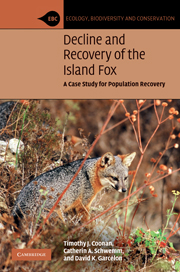Book contents
- Frontmatter
- Contents
- Foreword
- Acknowledgments
- 1 Introduction
- 2 Evolution and genetics
- 3 Social structure, reproduction, mortality and survivorship, and population dynamics
- 4 Food habits, habitat use, activity patterns, and dispersal
- 5 Golden eagles and the decline on the northern islands
- 6 Ecosystem recovery
- 7 Disease and decline on Santa Catalina Island
- 8 Recovery actions
- 9 Recovery actions
- 10 Reproductive biology, by Cheryl Asa
- 11 Diseases of island foxes, by Linda Munson
- 12 Zoos, education, and public participation
- 13 Managing recovery
- 14 The ecological role of island foxes
- 15 Conclusion
- References
- Index
Foreword
Published online by Cambridge University Press: 05 October 2010
- Frontmatter
- Contents
- Foreword
- Acknowledgments
- 1 Introduction
- 2 Evolution and genetics
- 3 Social structure, reproduction, mortality and survivorship, and population dynamics
- 4 Food habits, habitat use, activity patterns, and dispersal
- 5 Golden eagles and the decline on the northern islands
- 6 Ecosystem recovery
- 7 Disease and decline on Santa Catalina Island
- 8 Recovery actions
- 9 Recovery actions
- 10 Reproductive biology, by Cheryl Asa
- 11 Diseases of island foxes, by Linda Munson
- 12 Zoos, education, and public participation
- 13 Managing recovery
- 14 The ecological role of island foxes
- 15 Conclusion
- References
- Index
Summary
Ninety-nine percent of all the species that have ever existed on Earth are extinct, including all species of humans except our own. Undoubtedly, as humans evolved from four legs to two, from forest to the plains, and from hunter-gatherer to agrarian society, we, and our forebears, contributed to some of these extinctions. In modern times, we continue to contribute to the extinction of species, and at an alarming rate. What makes our behavior different than in prehistoric times is that humans now recognize the impacts of our actions on species' persistence, and we can take action, if we so choose, to reverse species loss. Sometimes our response is too little too late, as with the passenger pigeon that once blotted the sky with its fecundity but today resides only in the dusty drawers of museum cabinets. But at other times humans are successful at saving species, and in those instances we should pause to celebrate our achievements, and to consider the ingredients that bring a species back from the brink of extinction.
Such is the story of the Channel Islands fox. Off the California coast lies a small chain of islands, distant enough to make movement of animals from the mainland rare and difficult, and isolated for long enough that those species that did reach the islands have adapted and evolved, like Darwin's finches. Indeed the Channel Islands have been called the American Galapagos, once home to pigmy mammoths and later the hunting grounds of the Chumash people.
- Type
- Chapter
- Information
- Decline and Recovery of the Island FoxA Case Study for Population Recovery, pp. xii - xiiiPublisher: Cambridge University PressPrint publication year: 2010



